PHOTO
LONDON - Cut in June or not at all? The Bank of England is left parsing policy between a European Central Bank nailed on for cutting rates by mid-year and a U.S. Federal Reserve some feel may not be ready to ease at all in 2024.
Not for the first time, the BoE finds itself somewhere in the middle of the North Atlantic trying to set its own course - possibly leaning stateside due to lagging UK disinflation but in the euro zone current when it comes to flagging economic activity.
For much of the first quarter, financial markets conspicuously priced all three major central banks pulling their first rate cut triggers in tandem this summer - but a rift has opened up this month and timelines have scattered.
BoE chief economist Huw Pill on Tuesday said the Bank could move policy independently of the Fed and the ECB, though he seemed non-committal on which it might be leaning closer to.
It's left for markets to make up their own mind it seems.
After a slightly confusing few days of 'BoE-speak' that had governor Andrew Bailey and his deputy Dave Ramsden late last week sounding dovish on hitting the BoE's inflation target and staying there, resident hawk Jonathan Haskel pushed back again on that on Tuesday and Pill seemed more cautious.
As it stands, money markets currently fully price a first quarter-point BoE rate cut by its Aug. 1 meeting - with a roughly 50-50 chance of a move as soon as June 20.
That timeline is still remarkably close to guesstimates about the ECB, which is more than fully priced to ease 25 basis points (bps) by July 18 - just two weeks before the favoured BoE date - and some two-thirds priced for an early move as soon as June.
The Fed, on the other hand, is now not pencilled in to deliver until Sept. 18's policy meeting - with just a 50% chance that it moves as soon as July 31.
Of course it's still not inconceivable that all three end up moving together in the fortnight between July 18 and Aug. 1.
But where the gaps open up further is in implied year-end rates - where just 40 bps of cuts are now seen from the Fed, 55 bps from the BoE and almost 75 bps from the ECB.
And that market pricing masks considerable divergence in views over the timing and the extent of future UK cuts.
Barclays strategists now reckon the BoE will start to cut as soon as June and lop as much as 75 bps off its policy rate by year-end, even as it cut back expectations on the extent of the full easing cycle through next year by some 50 bps and put a tentative 'terminal rate' at 3.75%.
Having last week pushed his forecast for a first UK cut out to June from May, Deutsche Bank's chief UK economist Sanjay Raja thinks there's 75 bps in the pipeline for this year - though sees deeper cuts through 2025 to as low as 3% in early 2026.
MIND THE FX GAP
On one level, much of the big post-pandemic spike and subsequent retreat of global inflation has largely been common to all major central banks due to energy and supply chain disruptions. Differences between them now stem more from the residual domestic factors related to labour markets and service sector inflation that characterise the so-called 'last mile'.
But currency markets are starting to gyrate on those shifting views - and may also now play a role themselves.
The BoE's trade-weighted sterling index dropped more than 1% this month as markets detected a twist in Threadneedle Street thinking.
Given that the trade-weighted pound has appreciated 3% over the past year - and some 10% from the lows hit after the disastrous budget blowup by then Prime Minister Liz Truss in late 2022 - the BoE may feel comfortable sounding more dovish than the hardline Fed at this point.
Barclays economists Jack Meaning and Abbas Khan point out that the early BoE rate hike in December 2021 - some three and seven months ahead of the Fed and ECB respectively - showed that it wasn't afraid of moving independently. The only barrier might be if moving alone seeded outsize exchange rate moves.
But they added that Barclays' work showed a rate divergence of 100 bps would weaken sterling by a little over 2% overall - and that in turn would add only about 10-20 bps to headline UK inflation.
"We do not consider this sufficient to change the path for UK policy."
And yet if sterling is a factor - should the BoE lean towards one or other of the two big central banks?
On the face of it, Britain's greater overall trade linkages with Europe despite the Brexit fracture might suggest sticking closer to the earlier ECB path. After all, almost 50% of all UK imports still come from the European Union and more than 40% of all exports still head there.
The wrinkle is dollar-denominated energy and commodities and other internationally-invoiced trade, however.
Data from the government's customs and excise office, for example, shows some 37% of total EU and non-EU imports to the UK are invoiced in dollars - more than those invoiced in sterling and almost twice those invoiced in euros.
And more than 40% of total UK exports are invoiced in dollars - three times the share invoiced in euros.
There are many moving parts in all that of course.
But if sterling moves do become a concern, it's not all that obvious which way to tilt between the dominant Western blocs and ploughing a middle furrow may well be the safest way to go.
The opinions expressed here are those of the author, a columnist for Reuters.
(Editing by Mark Potter)












